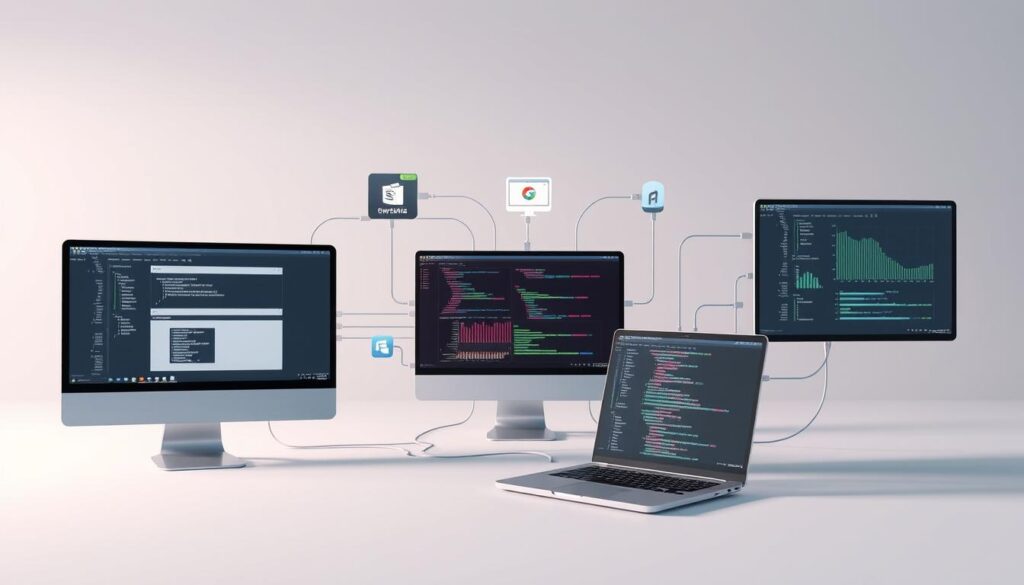The world of engineering is rapidly evolving, with over 70% of engineers relying on specialized engineering programs to design, simulate, and optimize their projects.
With so many software for engineering available, selecting the right one can be daunting. The right engineering software tools can significantly enhance productivity, improve accuracy, and reduce project timelines.
By understanding the features and benefits of various engineering software tools, engineers can make informed decisions that drive project success.
Key Takeaways
- Identify the most suitable engineering software for your project needs.
- Understand the key features and benefits of popular engineering programs.
- Learn how to optimize your workflow with the right software for engineering.
- Discover how to improve project accuracy and reduce timelines.
- Explore the latest trends in engineering software tools.
Understanding Engineering Software Tools
In the realm of engineering, software tools play a crucial role in streamlining processes and improving outcomes. These tools are designed to enhance productivity, accuracy, and collaboration among engineers. With a wide range of software available, understanding their definition, importance, and key features is essential for making informed decisions.
Definition and Importance
Engineering software tools refer to applications and programs used to design, analyze, simulate, and manage engineering projects. These tools are vital for engineers as they facilitate complex calculations, modeling, and data analysis, thereby reducing the risk of errors and improving project efficiency. For instance, AutoCAD is a widely used software for civil engineering that enables precise design and drafting.
The importance of engineering software tools lies in their ability to:
- Enhance design accuracy and precision
- Streamline project management tasks
- Facilitate collaboration among team members
- Reduce project timelines and costs
Key Features to Look For
When selecting engineering software, several key features should be considered. These include:
| Feature | Description | Benefit |
|---|---|---|
| User Interface | Intuitive and user-friendly design | Reduces learning curve and enhances productivity |
| Compatibility | Ability to integrate with other software and systems | Facilitates seamless data exchange and collaboration |
| Customization | Options for tailoring the software to specific needs | Enhances flexibility and adaptability |
By understanding the definition, importance, and key features of engineering software tools, engineers and organizations can make informed decisions when selecting software that meets their specific needs. The right software can significantly impact project outcomes, making it a critical component of modern engineering practices.
Categories of Engineering Software Tools
To navigate the complex landscape of engineering software, it’s essential to understand the different categories of tools available. These categories help engineers and project managers choose the right software for their specific needs, enhancing productivity and project outcomes.
Design Software
Design software is a cornerstone of engineering, enabling the creation of detailed designs and models. Tools like AutoCAD and SolidWorks are widely used for drafting and 3D modeling. These programs offer a range of features, from basic drawing tools to advanced simulation capabilities, facilitating the design process from concept to completion.

Simulation Tools
Simulation tools allow engineers to test and validate their designs in a virtual environment. Software such as MATLAB and ANSYS provide advanced simulation capabilities, enabling the analysis of complex systems and the prediction of how designs will perform under various conditions.
Project Management Software
Effective project management is crucial for the successful delivery of engineering projects. Software tools like Asana, Trello, and MS Project help in planning, organizing, and tracking project progress. These tools facilitate collaboration, resource allocation, and scheduling, ensuring that projects are completed on time and within budget.
Collaboration Platforms
Collaboration is key in engineering projects, which often involve large teams and multiple stakeholders. Platforms such as Slack and Microsoft Teams enable seamless communication and collaboration. These tools provide features like file sharing, video conferencing, and real-time messaging, enhancing teamwork and productivity.
By understanding the different categories of engineering software tools, professionals can make informed decisions about the tools that best suit their needs, ultimately leading to more efficient and successful project outcomes.
Top Engineering Software Tools in 2023
In 2023, the top engineering software tools are revolutionizing the way engineers work, design, and innovate. These tools have become indispensable for professionals across various engineering disciplines, enhancing productivity, precision, and collaboration.
AutoCAD: Revolutionizing Design
AutoCAD continues to be a leading choice among engineers for design and drafting. Its comprehensive set of tools enables users to create precise 2D and 3D models. Key features include automated tasks, advanced annotation tools, and enhanced collaboration capabilities.
With AutoCAD, engineers can streamline their design processes, reduce errors, and improve project outcomes. The software’s ability to integrate with other engineering tools further enhances its utility.
SolidWorks: 3D Modeling Made Easy
SolidWorks is renowned for its powerful 3D modeling capabilities, making it a favorite among mechanical engineers and product designers. The software offers an intuitive interface and a wide range of features that simplify complex design tasks.
Notable features of SolidWorks include its advanced simulation tools, which allow for real-world testing of designs without the need for physical prototypes, and its comprehensive library of pre-built components.
MATLAB: For Advanced Engineering Computations
MATLAB is a high-level programming language and environment specifically designed for numerical computation and data analysis. It is widely used in various engineering fields for tasks such as data analysis, algorithm development, and simulation.
The software’s key strengths include its extensive range of toolboxes and its ability to handle complex mathematical operations, making it an essential tool for engineers working on advanced projects.
These top engineering software tools in 2023 are not only enhancing the engineering workflow but are also contributing to the development of innovative solutions across industries.
Benefits of Using Engineering Software Tools
The adoption of engineering software tools has revolutionized the way projects are managed and executed. By leveraging these tools, engineers can significantly enhance their productivity, collaboration, and overall project outcomes.

Increased Efficiency
One of the primary benefits of engineering software applications is the increase in efficiency they bring to projects. These tools automate many routine tasks, allowing engineers to focus on more complex and creative aspects of their work. For instance, engineering software for product development can streamline the design process, reducing the time and effort required to bring a product to market.
Enhanced Collaboration
Top engineering tools also facilitate enhanced collaboration among team members. By providing a centralized platform for data sharing and project management, these tools ensure that all stakeholders are on the same page. This is particularly important in large, complex projects where multiple teams are involved. For example, using AutoCAD Civil 3D for road design can improve collaboration among civil engineers, designers, and contractors.
Cost-effectiveness
Finally, engineering software solutions can lead to significant cost savings. By reducing the need for physical prototypes, minimizing errors, and optimizing designs, these tools can help engineers deliver projects within budget. Moreover, the increased efficiency and productivity gained through these tools can lead to faster project completion times, further reducing costs.
In conclusion, the benefits of using engineering software tools are multifaceted, ranging from increased efficiency and enhanced collaboration to cost-effectiveness. As the engineering landscape continues to evolve, the adoption of these tools will become increasingly important for staying competitive.
Selection Criteria for Engineering Software
The right engineering software can streamline processes, enhance productivity, and drive project success. When it comes to selecting the ideal software for engineering needs, several factors come into play.
Assessing Your Project Needs
Understanding the specific requirements of your project is the first step in choosing the right engineering software. Consider the type of project, the complexity of the tasks involved, and the desired outcomes. For instance, if you’re working on a design-intensive project, you might need software with advanced CAD capabilities.
The key is to identify the core functionalities you need. Make a list of the features that are non-negotiable for your project’s success. This could include 2D or 3D modeling, simulation tools, or collaboration features. By doing so, you’ll be able to narrow down your options and focus on software that meets your needs.
User-Friendliness and Support
The usability of the software is another critical factor. Engineering software that is difficult to use can lead to frustration and decreased productivity. Look for software with an intuitive interface that your team can easily navigate. Additionally, consider the level of support provided by the software vendor, including tutorials, customer service, and user communities.
A software tool with robust support can significantly reduce the learning curve and help your team get up to speed quickly. Check if the vendor offers regular updates and if there are active forums or user groups where you can seek help.
Compatibility with Existing Systems
Ensuring that the new software is compatible with your existing systems is vital. This includes checking if the software can integrate with other tools you’re currently using, such as project management software or other engineering applications. Compatibility can save you time and resources by streamlining your workflow.
Before making a final decision, test the software with your existing systems to ensure seamless integration. This step can help you avoid potential headaches down the line.
Industry-Specific Engineering Software
Industry-specific engineering software is revolutionizing the way professionals design, simulate, and manage projects. Different engineering disciplines have unique requirements, and using the right software can significantly impact productivity and project outcomes.

Civil Engineering Tools
Civil engineering projects, such as infrastructure development and construction, rely heavily on specialized software. Tools like civil engineering project management software help in planning, designing, and managing complex projects. These tools often include features for structural analysis, geotechnical analysis, and project scheduling.
Some of the key civil engineering tools include software for building information modeling (BIM), geographic information systems (GIS), and computer-aided design (CAD). These tools enable civil engineers to create detailed models, analyze environmental impacts, and collaborate more effectively with stakeholders.
Mechanical Engineering Solutions
Mechanical engineers benefit from software that aids in design, simulation, and testing. 3D modeling and CAD software are crucial for creating complex mechanical systems. Simulation tools allow engineers to test their designs under various conditions, reducing the need for physical prototypes and speeding up the development process.
Some notable mechanical engineering solutions include SolidWorks and Autodesk Inventor, which offer comprehensive design and simulation capabilities. These tools help mechanical engineers optimize their designs, improve product performance, and reduce production costs.
Electrical Engineering Applications
Electrical engineers rely on software for designing, simulating, and testing electrical systems. Tools like SPICE simulators and electronic design automation (EDA) software are essential for developing complex electronic circuits and systems.
For instance, electrical engineers use software to design printed circuit boards (PCBs), simulate circuit behavior, and analyze signal integrity. These applications help in creating more reliable and efficient electrical systems, from consumer electronics to industrial control systems.
By leveraging industry-specific engineering software, professionals across different engineering disciplines can enhance their productivity, improve project outcomes, and drive innovation. For more insights on top engineering software tools, visit the best 10 engineering design software.
The Role of Cloud Computing in Engineering Software
The integration of cloud computing in engineering software has transformed the way professionals work, collaborate, and innovate. By leveraging cloud-based solutions, engineers can access powerful tools and resources from anywhere, at any time, enhancing productivity and efficiency.
Benefits of Cloud-Based Solutions
Cloud computing offers numerous benefits for engineering software platforms, including scalability, flexibility, and cost-effectiveness. These advantages enable businesses to adapt quickly to changing project requirements without significant upfront investments in hardware or software.
Moreover, cloud-based solutions facilitate enhanced collaboration among team members by providing a centralized platform for data sharing and project management. This leads to improved communication, reduced errors, and faster project completion times.
Top Cloud Engineering Tools
Several cloud engineering tools have gained popularity due to their robust features and capabilities. Some of the top tools include:
- Autodesk Fusion 360: A comprehensive CAD, CAM, and CAE tool that offers cloud-based collaboration and processing.
- Siemens MindSphere: A cloud-based IoT operating system that connects products, plants, and systems to the cloud.
- ANSYS Cloud: A cloud-based platform for simulation and analysis, providing scalable and secure computing resources.
These tools not only enhance the engineering design and development process but also provide real-time data analysis and predictive maintenance capabilities, further optimizing project outcomes.
Integration Capabilities with Other Software
Seamless integration with other software tools is no longer a luxury, but a necessity for engineering teams. As projects become more complex, the need for different software tools to work together seamlessly is crucial for efficiency and productivity.
The Importance of Integration
Integration capabilities allow different engineering software tools to exchange data and workflows, creating a cohesive and streamlined process. This is particularly important in engineering projects where design software, simulation tools, and project management software need to work together.
For instance, integrating CAD software with simulation tools enables engineers to test designs virtually before physical prototypes are made. This not only saves time but also reduces costs associated with physical testing. Moreover, integrating project management software with design tools ensures that all team members are on the same page, enhancing collaboration and reducing misunderstandings.

Popular Integration Options
Several engineering software tools offer robust integration options. For example, software integration platforms provide pre-built connectors for popular engineering software, making it easier to integrate different tools.
Some of the popular integration options include:
| Integration Type | Description | Benefits |
|---|---|---|
| CAD and Simulation | Integrates design and simulation tools for virtual testing | Reduces physical prototyping costs, enhances design validation |
| Project Management and Design | Links project management software with design tools | Improves collaboration, ensures project timelines are met |
| Collaboration Platforms | Integrates team collaboration tools with engineering software | Enhances communication, reduces project delays |
By leveraging these integration capabilities, engineering teams can create a more efficient and productive workflow, ultimately leading to better project outcomes.
Future Trends in Engineering Software Tools
The future of engineering software tools is rapidly evolving with technological advancements. As we look ahead, several key trends are poised to shape the industry.
AI and Machine Learning Impact
Artificial intelligence (AI) and machine learning (ML) are increasingly being integrated into engineering software solutions. These technologies enable more efficient design processes, predictive analytics, and optimized performance. For instance, AI-powered tools can automate repetitive tasks, freeing up engineers to focus on more complex problems.
According to a recent article on top emerging trends in software development, AI and ML are expected to play a significant role in shaping the future of engineering software.
Virtual Reality and Augmented Reality
Virtual reality (VR) and augmented reality (AR) are transforming the way engineers design and interact with their projects. These technologies provide immersive experiences, enhancing collaboration and reducing errors. For example, VR can be used to visualize complex designs, while AR can overlay digital information onto real-world environments.
| Trend | Description | Benefits |
|---|---|---|
| AI and ML | Integration of AI and ML into engineering software | Improved efficiency, predictive analytics |
| VR and AR | Use of VR and AR for immersive experiences | Enhanced collaboration, reduced errors |
As these trends continue to evolve, it’s essential for engineers and organizations to stay informed about the best engineering software that incorporates these technologies. By doing so, they can remain competitive and take advantage of the latest innovations in engineering software solutions.
Custom Engineering Software Solutions
In the realm of engineering, custom software solutions are revolutionizing the way projects are managed and executed. As engineering projects become increasingly complex, the need for tailored software that can address specific challenges is growing.
Custom engineering software development allows businesses to create tools that are precisely aligned with their operational needs, enhancing efficiency and productivity. Enabling a transition to custom engineering can be a strategic move for companies looking to differentiate themselves through technology.
When to Consider Customization
Customization should be considered when off-the-shelf software solutions fail to meet the specific needs of an engineering project. This could be due to unique project requirements, the need for integration with existing systems, or the desire to improve workflow efficiency.
Key indicators that customization might be necessary include:
- Repeated manual workarounds for software limitations
- Inability to integrate with existing software tools
- Specific project requirements not met by standard software
Examples of Successful Custom Solutions
Several companies have successfully implemented custom engineering software solutions to address their unique challenges. For instance, a leading civil engineering firm developed a custom solution for managing large-scale infrastructure projects, resulting in improved project timelines and reduced costs.
The benefits of such custom solutions include enhanced collaboration, improved data accuracy, and streamlined project management.
| Industry | Custom Solution | Benefits |
|---|---|---|
| Civil Engineering | Project Management Tool | Improved Timelines, Reduced Costs |
| Mechanical Engineering | Design Automation Software | Increased Efficiency, Enhanced Accuracy |
| Electrical Engineering | Circuit Simulation Tool | Better Design Validation, Reduced Prototyping Costs |

Open Source Engineering Software Tools
With the rise of open source initiatives, engineering software tools have become more diverse and innovative. Open source software has democratized access to advanced engineering tools, allowing a broader range of professionals to participate in the development and customization of these tools.
Benefits of Open Source
Open source engineering software offers several benefits, including cost-effectiveness and community-driven development. These tools are often free or low-cost, reducing the financial burden on individuals and organizations. Moreover, the open source community contributes to the continuous improvement and customization of the software.
- Flexibility and customizability
- Community support and feedback
- Rapid development and updates
Notable Open Source Tools
Some notable open source engineering software tools include FreeCAD, OpenFOAM, and KiCad. These tools cater to various engineering disciplines, such as mechanical, electrical, and civil engineering.
| Tool | Description | Discipline |
|---|---|---|
| FreeCAD | A parametric 3D modeler | Mechanical Engineering |
| OpenFOAM | A CFD software package | Mechanical/Chemical Engineering |
| KiCad | An EDA software suite | Electrical Engineering |
The use of open source engineering software tools is on the rise, driven by their flexibility, community support, and cost-effectiveness. As the engineering community continues to adopt these tools, we can expect to see further innovations and advancements in the field.
Cost Considerations for Engineering Software Tools
The financial aspect of engineering software tools is a critical factor that influences the choice of software for many professionals and organizations. When evaluating these tools, it’s not just about the initial cost; several factors come into play to determine the total cost of ownership and the return on investment.

Pricing Models
Engineering software tools employ various pricing models, each with its advantages and disadvantages. Some common models include:
- Subscription-based: Offers flexibility and regular updates, often with cloud-based services.
- Perpetual License: Involves a one-time purchase fee, with optional maintenance and support fees for updates.
- Freemium: Basic features are free, with premium features available at a cost.
- Open Source: Free to use, modify, and distribute, though may require expertise for customization and support.
Understanding these pricing models is crucial for budgeting and selecting the most cost-effective solution for your engineering needs.
Budgeting for Software Investments
Budgeting for engineering software involves more than just the software cost. It includes:
- Training and Support: Costs associated with training staff and ongoing support.
- Hardware Requirements: Potential need for hardware upgrades to run the software efficiently.
- Customization: Costs for customizing the software to meet specific project needs.
- Integration: Expenses related to integrating the software with existing systems.
By considering these factors, organizations can make more informed decisions about their software investments, ensuring they get the best value for their money.
How to Stay Updated with Software Advancements
To stay ahead in the field of engineering, it’s essential to keep pace with the latest software developments. The engineering software landscape is constantly evolving, with new tools and features being introduced regularly.
Resources for Continuous Learning
Continuous learning is vital for engineering professionals to remain proficient in using the latest software tools. There are numerous resources available that can aid in this endeavor. For instance, online courses can provide in-depth knowledge on specific software applications.
Some of the key resources include:
- Online tutorials and webinars
- Professional certification programs
- Industry conferences and workshops
These resources not only enhance technical skills but also offer insights into the latest industry trends and best practices.
Networking and Industry Events
Networking with peers and participating in industry events are crucial for staying updated. Conferences, trade shows, and seminars provide opportunities to learn from industry experts and share experiences.
Some benefits of attending industry events include:
- Learning about new software features and applications
- Networking with other professionals
- Staying informed about industry trends
By leveraging these resources and staying connected with the engineering community, professionals can ensure they remain at the forefront of software advancements.
User Reviews and Case Studies
The true measure of engineering software lies in its practical application, as reflected in user reviews and success stories. By examining how others have utilized these tools, potential users can gain a deeper understanding of their capabilities and limitations.
Importance of Feedback
Feedback from existing users is crucial as it provides firsthand information about the software’s performance in real-world scenarios. This feedback can highlight strengths and weaknesses, helping others make informed decisions. For instance, reviews on platforms like DevExpress testimonials showcase the positive experiences of users, offering insights into the software’s effectiveness.

Notable Success Stories
Several case studies demonstrate the transformative impact of engineering software. For example, companies that have adopted innovative design tools have reported significant improvements in productivity and project outcomes. These success stories not only validate the software’s capabilities but also inspire other organizations to explore similar solutions.
By leveraging user reviews and case studies, businesses can better navigate the complex landscape of engineering software, ultimately selecting tools that align with their specific needs and goals.
Implementing Software Tools in Your Workflow
To maximize the benefits of engineering software, it’s essential to implement it correctly within your workflow. Effective implementation can lead to increased efficiency, better collaboration, and improved project outcomes.
Best Practices for Adoption
Adopting new software tools requires a strategic approach. Here are some best practices to consider:
- Assess Your Needs: Identify the specific needs of your projects and teams to choose the most appropriate software.
- Provide Comprehensive Training: Ensure that all users are adequately trained to use the software effectively.
- Start Small: Begin with a pilot project to test the software’s capabilities and user acceptance.
- Monitor Progress: Regularly review the impact of the software on your workflow and make adjustments as necessary.

Common Challenges and Solutions
Despite the benefits, implementing software tools can come with challenges. Here are some common issues and their solutions:
- Resistance to Change: Some team members may be hesitant to adopt new software. Solution: Provide thorough training and involve users in the selection process to increase buy-in.
- Integration Issues: New software may not integrate seamlessly with existing systems. Solution: Choose software with robust integration capabilities or work with vendors to develop custom integrations.
- Cost Concerns: The cost of new software can be a barrier. Solution: Conduct a cost-benefit analysis to demonstrate the long-term value of the investment.
By following best practices and being aware of potential challenges, you can successfully implement software tools in your workflow, leading to improved efficiency and project success.
Conclusion: Choosing the Right Software Tool for Success
Selecting the right engineering software tool is crucial for the success of any project. With numerous options available, it’s essential to consider several key factors to make an informed decision.
Key Considerations for Success
When choosing an engineering software tool, consider your project needs, user-friendliness, and compatibility with existing systems. Assessing these factors will help you identify the most suitable tool for your specific requirements.
Final Thoughts on Engineering Software
The right software tool can significantly enhance your project’s efficiency, collaboration, and overall success. By understanding the key considerations and staying updated with the latest advancements, you can make the most of your engineering software investment.
Ultimately, choosing the right software tool requires careful evaluation and consideration of your project’s unique needs. By doing so, you can ensure the successful completion of your project and stay ahead in the competitive engineering landscape.
